
FIELD UPDATE FROM BRENTON
01/31/20 — Ada Broussard
We sat down with Brenton this week and got the lowdown on happenings in the field. Per usual, there are a lot of happenings.
![]() Early morning manager meetings in the shelter of the greenhouse. Photo by Scott David Gordon.
Early morning manager meetings in the shelter of the greenhouse. Photo by Scott David Gordon.
Planting This is “go time” at the farm, and things are “really getting crazy”, according to Brenton. It goes without saying. All that beautiful spring bounty that you expect from farms? Well, that bounty is all being planted, now, and before it can be planted, it must be seeded, beds must be prepped, drip tape laid, and compost spread. Our greenhouse, as well as our hardening-off area outside the greenhouse, are full of transplants that need to be planted including fennel, leeks, kale, as well as brassicas like cabbage, broccoli, and cauliflower. Last week we got rained out on several days, so we’re a bit behind schedule with these transplants. We’re also trying to get our potatoes in the ground, which take about two weeks for their greens to poke out from the earth, and should be planted around two weeks before the average last frost. Which, believe it or not, is quickly approaching!
![]() Transplants hardening off outside our greenhouse, waiting for their turn to go into the ground. Photo by Scott David Gordon.
Transplants hardening off outside our greenhouse, waiting for their turn to go into the ground. Photo by Scott David Gordon.
In addition to trying to get our transplants and potatoes in the ground, we’re also beginning to gear up for another large round of direct seeded crops like beets and carrots. The weather hasn’t been perfect for direct seeding - the ground is a bit too damp in some areas of the farm and we’re having to be conservative… even though the ticking clock and a general sense of spring-fever has us wanting to plant, plant, plant.
Crops This has been a mild winter. Without pouring over data to confirm, we’ll go ahead and say that this definitely feels like the warmest and mildest winter we’ve had as a farm. Though our farm crews’ fingertips may benefit from this warmer weather, our cool-season crops haven’t had the same luck.
Case in point: beets. Which, are back! (Finally!) If you’re a CSA Member or market patron, you may have noticed the mysterious absence of beets in your JBG haul, a crop that usually defines our fall and winter season. We planted three large rounds of beets, begging in early fall, that all failed. Round one didn’t germinate properly due to the really hot weather that extended into the fall. Round two germinated beautifully! And then, came the hogs. They decimated our second planting of beets. Round three of beets was plagued by army worms, a pest that is usually deterred by the cold, but without any extreme cold, the worms prevailed. Unfortunately, this march of army worms hit at an extremely busy time in the fall (when we were busy fighting weeds), and we just didn’t have the staff to properly deal with the pests. Goodbye, round three. Lucky for us, the fourth time was a charm, and beets of all colors were harvested every day this week.
![]() Beets are finally here. Have you missed them like we have? Photo by Scott David Gordon.
Beets are finally here. Have you missed them like we have? Photo by Scott David Gordon.
Army worms aren’t the only pest that has thrived in this mild winter. The thrips, a pest that we usually expect to surface when the weather warms in late February, have made an extremely early appearance and are attaching themselves to our spring onion crop, their favorite feast. We’ll be fighting this generation of thrips hard, using neem oil and an extract from made from dried chrysanthemum flower heads called pyrethrum. Thrips, begone! Army worms, thrips, flea beetles… a lot of these bug populations usually get reduced by the cold weather, but with this mild winter we’re having, the bugs are here to test us.
![]() Look closely at this beautiful photo and you'll see tiny yellow bugs. These are thrips. If a few hitch a ride into your CSA box, don't worry: they're not dangerous and are merely annoying. Rinse them off, and continue on. Photo by Scott David Gordon.
Look closely at this beautiful photo and you'll see tiny yellow bugs. These are thrips. If a few hitch a ride into your CSA box, don't worry: they're not dangerous and are merely annoying. Rinse them off, and continue on. Photo by Scott David Gordon.
Equipment The one thing that tested us more than the bugs this week? Some of our equipment, specifically, our equipment that falls in the “antique” category. As we mentioned, it’s go-time for the direct seeing of our spring carrots and beets. This week, our beds were ready to go but surprisingly, our MaterMac seeder was not. Back when we first purchased this seeder, MaterMac was based in Italy, but has since then been sold to another company. Parts are hard to get, and even harder when you have a very old model, like ours. One MaterMac dealer is on the east coast, the other on the west coast, and after countless hours on the phone with each we learned that neither dealer had what we needed. In fact, we were originally told that the universal coupling we needed to make our seeder run “was obsolete, and did not exist”, which was a problem, because we needed not one of the couplings, but two.But, farmers aren’t really the giving-up type. We persisted, and learned that the west coast dealer had half of the assembly, and the east coast dealer had one whole assembly. With the parts that we still had at the farm, we were able to cobble together the other half, and after hours on the phone and two next-day air shipments, we were back in action.
![]() Jack, armed with a cell phone and spread sheets, scours the country for parts. Photo by Scott David Gordon.
Jack, armed with a cell phone and spread sheets, scours the country for parts. Photo by Scott David Gordon.
![]() Our Italian amico, the MaterMac. Photo by Scott David Gordon.
Our Italian amico, the MaterMac. Photo by Scott David Gordon.
This type of problem solving is typical… in fact, the seeder couplings weren’t the only parts we hunted for this week. The most geriatric tractor on our farm in our Case tractor, which is still the primary tractor we use for cultivation. It’s pretty common that we need to tinker with this sweet (but temperamental) tractor to get it started up, and this week whilst tinkering, we accidentally dropped a wrench in its depths and the radiator fan shattered.
Did we mention this tractor was old and special? We must have called 40 different places looking for a replacement radiator fan, but no one seemed to exist across the whole country. Finally, we found someone in Tennessee selling the identical, antique tractor. “All we need is the radiator fan. Can we buy that from you?” “Yep! For a hundred dollar bill!”. One Benjamin and another next-day air shipment later, and we were back in business.
![]() How could you ever be mad at this tractor? Photo by Scott David Gordon.
How could you ever be mad at this tractor? Photo by Scott David Gordon.
Looking Forward Tracy, one of our Hergotz managers, said it best this week, “There is so much positive momentum right now.” We are finishing harvesting some of our fall and winter plantings right now and are eager to get a fresh start this spring. Some of the crops you see right now might have a few tiny bug bites or might have edges that have been burned from an occasional freeze. We hope that these are friendly reminders that you’re eating organic produce, that is grown locally - produce that is unable to escape the realities of a particular weather season, and produce that also happens to be fresher and taste better than your average item from a grocery store.
The vegetables we grow may not always look perfect, especially at a moment like this, in between seasons and plantings when bugs are having a party, but this produce is not only nutritionally dense… it’s also delicious. When any degree of cold weather hits, our crops get busy converting some of their cells to a more sugary-version of themselves, yielding a sweeter and more delicious crop for you. Most of our crops are harvested one day, and delivered the next. They’re fresh as all get-up. If you’re new to eating local produce, it might take some time to shake the perfect standards that grocery stores have reinforced. These same standards, unfortunately, have been the cause of a vast amount of waste in our food system. To be clear, we don't want to have produce that ever looks damaged, but perfect produce comes at a financial cost to farms: it costs more fuel to drive over fields, to do another pest spray, all the while harming beneficial insects in the process.
We strive to strike a balance here, and we hope our update from the fields this week demonstrates all the figuring and phone calls that goes into creating that balance. Thanks for reading, and as always, thanks for supporting the farm.
![]() "What do you mean the seeder is broken?" Photo by Scott David Gordon.
"What do you mean the seeder is broken?" Photo by Scott David Gordon.
P.S. Speaking of positive momentum, are you planting a spring garden this year? If you’ve made it to the bottom of this post, you’ll be the first to know a little secret: Our Spring Transplant Sale is going live next week! Keep your eyes peeled!
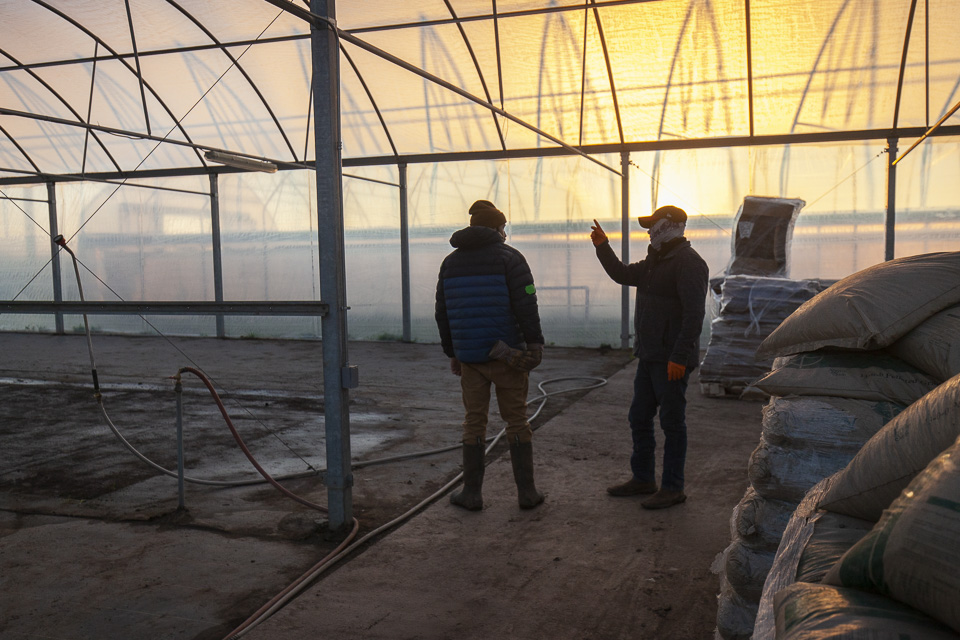 Early morning manager meetings in the shelter of the greenhouse. Photo by Scott David Gordon.
Early morning manager meetings in the shelter of the greenhouse. Photo by Scott David Gordon.
Planting This is “go time” at the farm, and things are “really getting crazy”, according to Brenton. It goes without saying. All that beautiful spring bounty that you expect from farms? Well, that bounty is all being planted, now, and before it can be planted, it must be seeded, beds must be prepped, drip tape laid, and compost spread. Our greenhouse, as well as our hardening-off area outside the greenhouse, are full of transplants that need to be planted including fennel, leeks, kale, as well as brassicas like cabbage, broccoli, and cauliflower. Last week we got rained out on several days, so we’re a bit behind schedule with these transplants. We’re also trying to get our potatoes in the ground, which take about two weeks for their greens to poke out from the earth, and should be planted around two weeks before the average last frost. Which, believe it or not, is quickly approaching!
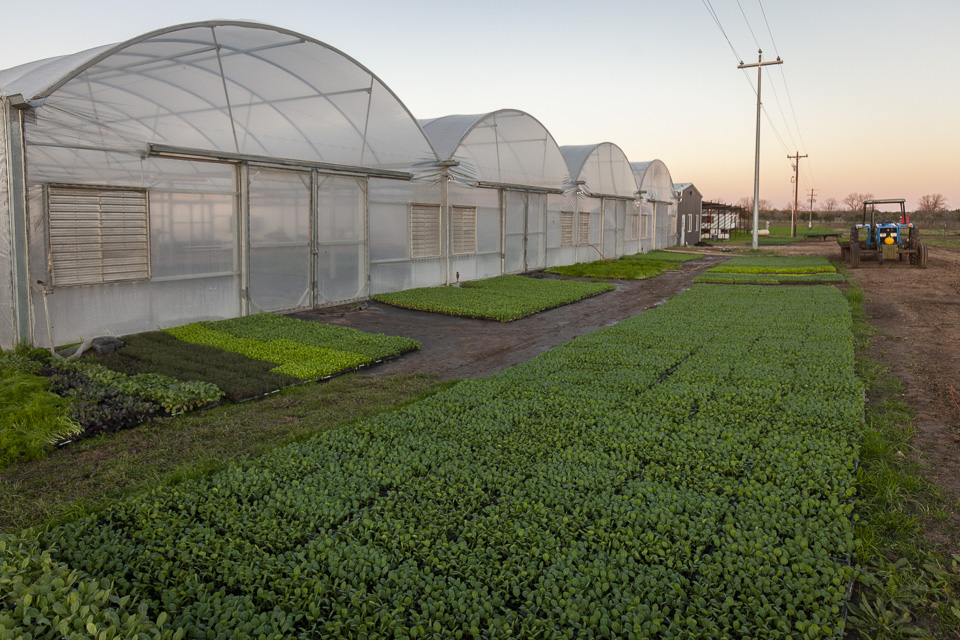 Transplants hardening off outside our greenhouse, waiting for their turn to go into the ground. Photo by Scott David Gordon.
Transplants hardening off outside our greenhouse, waiting for their turn to go into the ground. Photo by Scott David Gordon.
In addition to trying to get our transplants and potatoes in the ground, we’re also beginning to gear up for another large round of direct seeded crops like beets and carrots. The weather hasn’t been perfect for direct seeding - the ground is a bit too damp in some areas of the farm and we’re having to be conservative… even though the ticking clock and a general sense of spring-fever has us wanting to plant, plant, plant.
Crops This has been a mild winter. Without pouring over data to confirm, we’ll go ahead and say that this definitely feels like the warmest and mildest winter we’ve had as a farm. Though our farm crews’ fingertips may benefit from this warmer weather, our cool-season crops haven’t had the same luck.
Case in point: beets. Which, are back! (Finally!) If you’re a CSA Member or market patron, you may have noticed the mysterious absence of beets in your JBG haul, a crop that usually defines our fall and winter season. We planted three large rounds of beets, begging in early fall, that all failed. Round one didn’t germinate properly due to the really hot weather that extended into the fall. Round two germinated beautifully! And then, came the hogs. They decimated our second planting of beets. Round three of beets was plagued by army worms, a pest that is usually deterred by the cold, but without any extreme cold, the worms prevailed. Unfortunately, this march of army worms hit at an extremely busy time in the fall (when we were busy fighting weeds), and we just didn’t have the staff to properly deal with the pests. Goodbye, round three. Lucky for us, the fourth time was a charm, and beets of all colors were harvested every day this week.
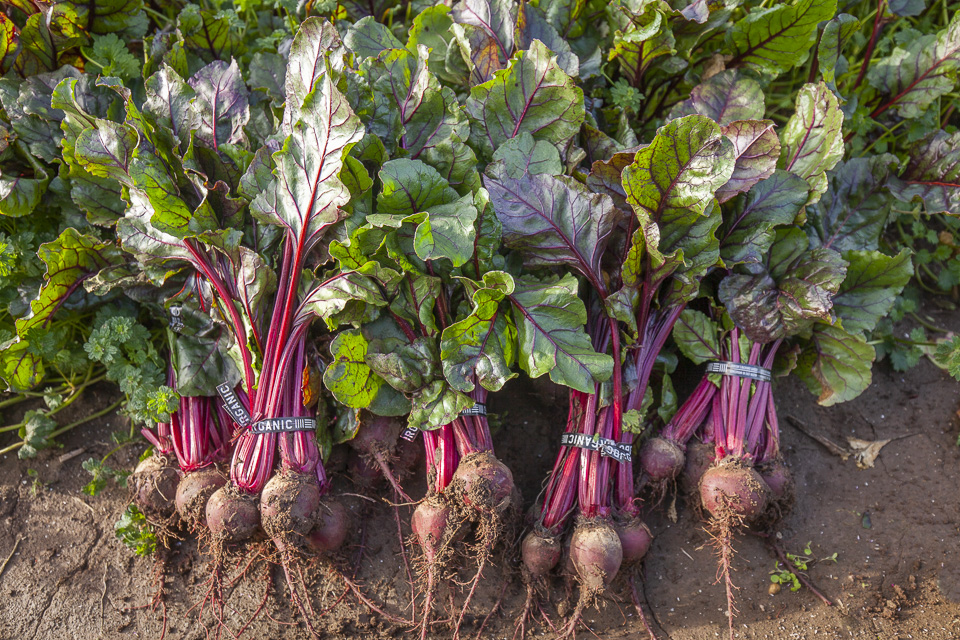 Beets are finally here. Have you missed them like we have? Photo by Scott David Gordon.
Beets are finally here. Have you missed them like we have? Photo by Scott David Gordon.
Army worms aren’t the only pest that has thrived in this mild winter. The thrips, a pest that we usually expect to surface when the weather warms in late February, have made an extremely early appearance and are attaching themselves to our spring onion crop, their favorite feast. We’ll be fighting this generation of thrips hard, using neem oil and an extract from made from dried chrysanthemum flower heads called pyrethrum. Thrips, begone! Army worms, thrips, flea beetles… a lot of these bug populations usually get reduced by the cold weather, but with this mild winter we’re having, the bugs are here to test us.
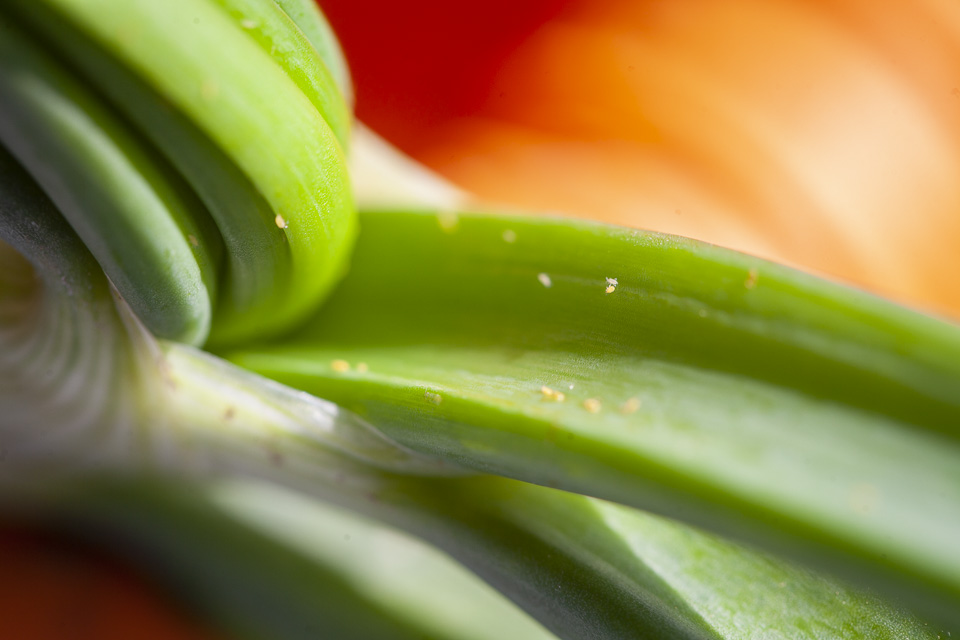 Look closely at this beautiful photo and you'll see tiny yellow bugs. These are thrips. If a few hitch a ride into your CSA box, don't worry: they're not dangerous and are merely annoying. Rinse them off, and continue on. Photo by Scott David Gordon.
Look closely at this beautiful photo and you'll see tiny yellow bugs. These are thrips. If a few hitch a ride into your CSA box, don't worry: they're not dangerous and are merely annoying. Rinse them off, and continue on. Photo by Scott David Gordon.
Equipment The one thing that tested us more than the bugs this week? Some of our equipment, specifically, our equipment that falls in the “antique” category. As we mentioned, it’s go-time for the direct seeing of our spring carrots and beets. This week, our beds were ready to go but surprisingly, our MaterMac seeder was not. Back when we first purchased this seeder, MaterMac was based in Italy, but has since then been sold to another company. Parts are hard to get, and even harder when you have a very old model, like ours. One MaterMac dealer is on the east coast, the other on the west coast, and after countless hours on the phone with each we learned that neither dealer had what we needed. In fact, we were originally told that the universal coupling we needed to make our seeder run “was obsolete, and did not exist”, which was a problem, because we needed not one of the couplings, but two.But, farmers aren’t really the giving-up type. We persisted, and learned that the west coast dealer had half of the assembly, and the east coast dealer had one whole assembly. With the parts that we still had at the farm, we were able to cobble together the other half, and after hours on the phone and two next-day air shipments, we were back in action.
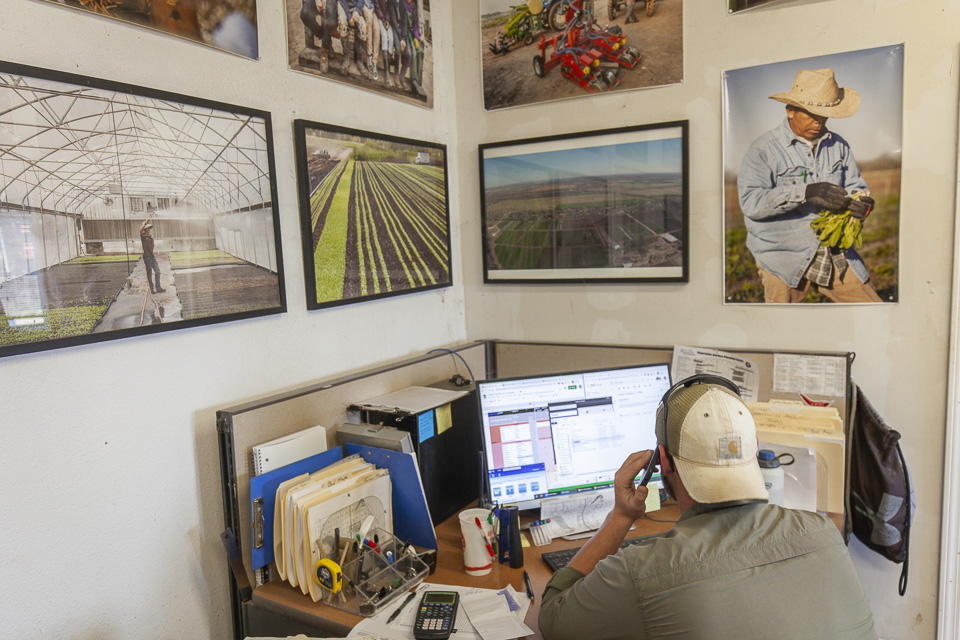 Jack, armed with a cell phone and spread sheets, scours the country for parts. Photo by Scott David Gordon.
Jack, armed with a cell phone and spread sheets, scours the country for parts. Photo by Scott David Gordon.
 Our Italian amico, the MaterMac. Photo by Scott David Gordon.
Our Italian amico, the MaterMac. Photo by Scott David Gordon.
This type of problem solving is typical… in fact, the seeder couplings weren’t the only parts we hunted for this week. The most geriatric tractor on our farm in our Case tractor, which is still the primary tractor we use for cultivation. It’s pretty common that we need to tinker with this sweet (but temperamental) tractor to get it started up, and this week whilst tinkering, we accidentally dropped a wrench in its depths and the radiator fan shattered.
Did we mention this tractor was old and special? We must have called 40 different places looking for a replacement radiator fan, but no one seemed to exist across the whole country. Finally, we found someone in Tennessee selling the identical, antique tractor. “All we need is the radiator fan. Can we buy that from you?” “Yep! For a hundred dollar bill!”. One Benjamin and another next-day air shipment later, and we were back in business.
 How could you ever be mad at this tractor? Photo by Scott David Gordon.
How could you ever be mad at this tractor? Photo by Scott David Gordon.
Looking Forward Tracy, one of our Hergotz managers, said it best this week, “There is so much positive momentum right now.” We are finishing harvesting some of our fall and winter plantings right now and are eager to get a fresh start this spring. Some of the crops you see right now might have a few tiny bug bites or might have edges that have been burned from an occasional freeze. We hope that these are friendly reminders that you’re eating organic produce, that is grown locally - produce that is unable to escape the realities of a particular weather season, and produce that also happens to be fresher and taste better than your average item from a grocery store.
The vegetables we grow may not always look perfect, especially at a moment like this, in between seasons and plantings when bugs are having a party, but this produce is not only nutritionally dense… it’s also delicious. When any degree of cold weather hits, our crops get busy converting some of their cells to a more sugary-version of themselves, yielding a sweeter and more delicious crop for you. Most of our crops are harvested one day, and delivered the next. They’re fresh as all get-up. If you’re new to eating local produce, it might take some time to shake the perfect standards that grocery stores have reinforced. These same standards, unfortunately, have been the cause of a vast amount of waste in our food system. To be clear, we don't want to have produce that ever looks damaged, but perfect produce comes at a financial cost to farms: it costs more fuel to drive over fields, to do another pest spray, all the while harming beneficial insects in the process.
We strive to strike a balance here, and we hope our update from the fields this week demonstrates all the figuring and phone calls that goes into creating that balance. Thanks for reading, and as always, thanks for supporting the farm.
 "What do you mean the seeder is broken?" Photo by Scott David Gordon.
"What do you mean the seeder is broken?" Photo by Scott David Gordon.
P.S. Speaking of positive momentum, are you planting a spring garden this year? If you’ve made it to the bottom of this post, you’ll be the first to know a little secret: Our Spring Transplant Sale is going live next week! Keep your eyes peeled!






 0 ITEMS IN CART
0 ITEMS IN CART 

